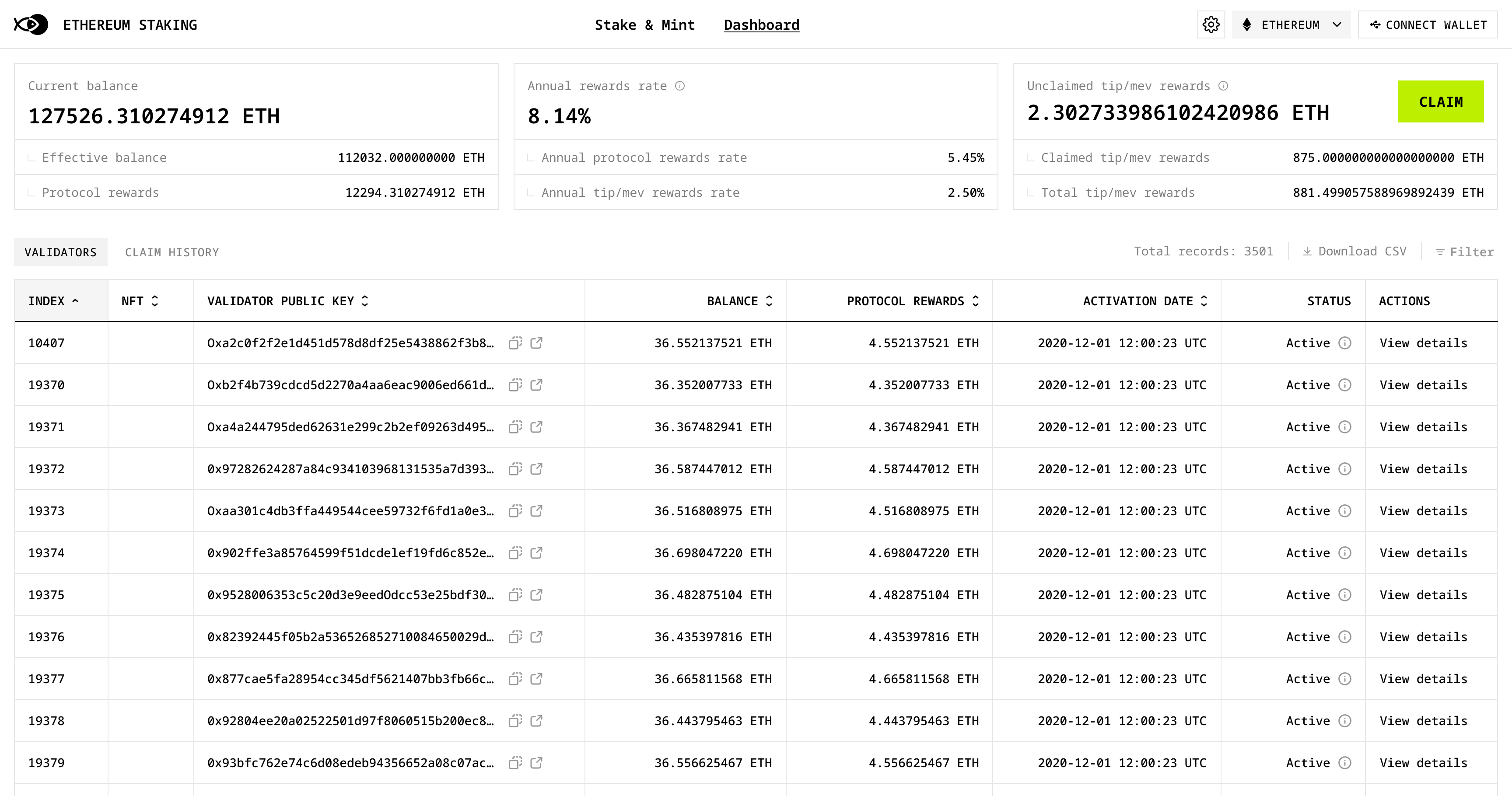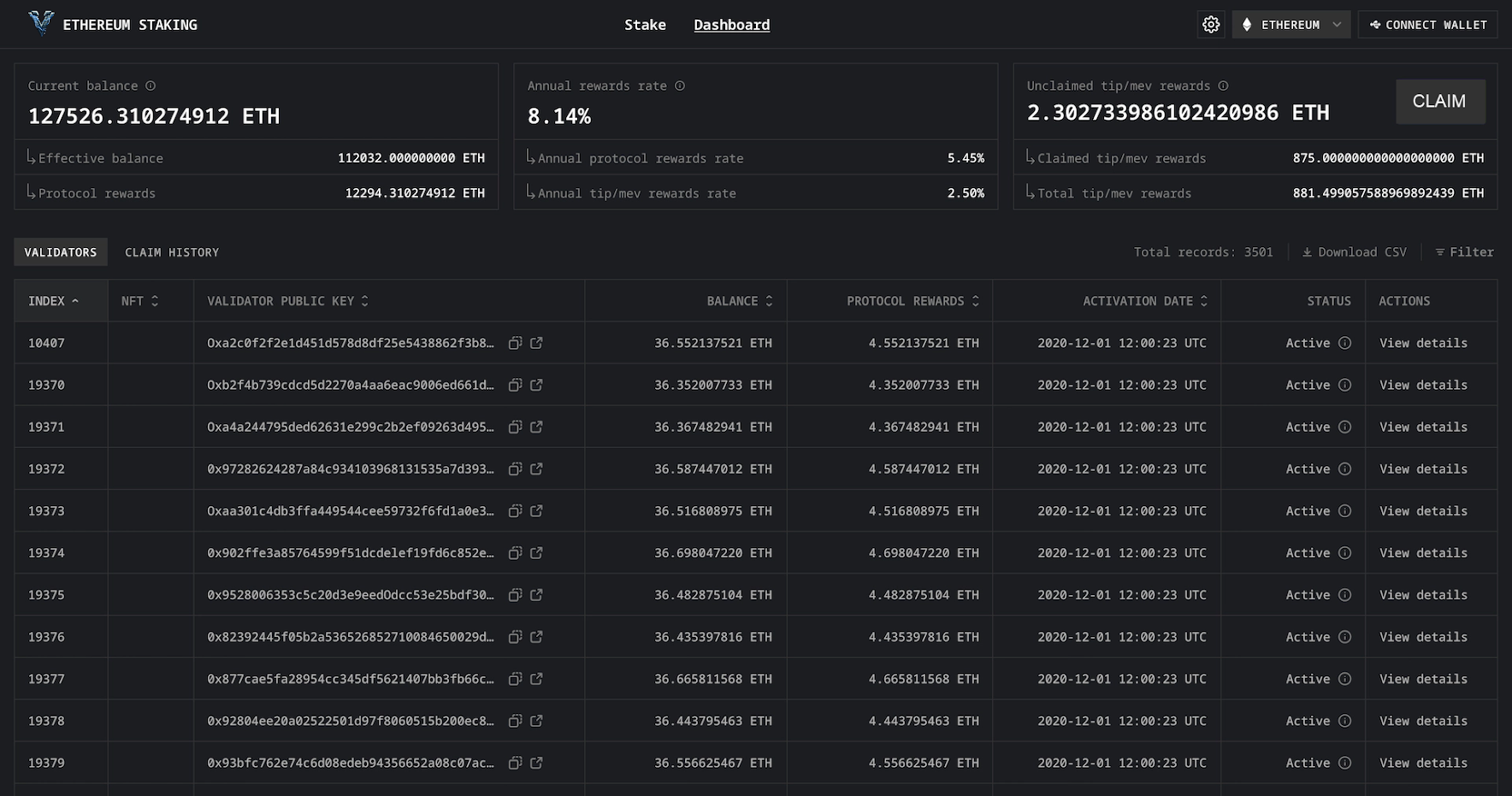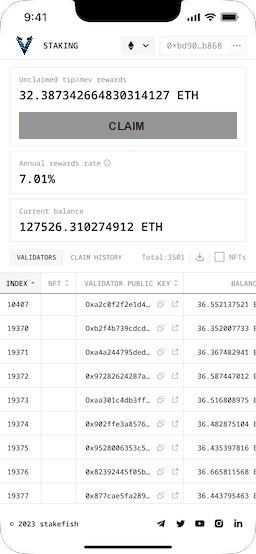StakeVault.Network
Unrivaled Ethereum
Staking Experience



Benefits
Dashboard
Dashboard to stay on top of all your validators, and all your rewards
Zero protocol fee
Pay zero fee on protocol rewards
Fee/mev rewards
Extract maximum execution layer fees, 50% increased yields
Infrastructure
World-class infrastructure with 100% participation, zero slashing, maximum rewards
DeFi-ready
Option to stake as NFT for collateralization and DeFi
Made for everyone
Built for small stakers and big stakers alike
Our products
Classic staking
Dashboard access
Native staking
Fee/mev fee pool
NFT staking
Dashboard access
Fee/mev fee pool
NFT controls validator
Transfer ownership
Collateralize staking position
Buy/sell to exit without unbonding period
Numbers
First staked
GENESIS
Staked
887,168 ETH
Collected fee/mev pool The amount only represents only a portion of the all the validators staked with StakeVault.
5,863 ETH
Validators
27,724
Rewards calculator
32 ETH
Validators
1
Protocol rewards per week
0.017747857 ETH
2.89% APR
Tip/mev pool earnings per week
0.004075606259273704 ETH
0.66% APR
Protocol rewards commission
0%
fee
Tip/mev rewards commission
25%
fee
Total Rewards
3.94% APR
Get started today
Frequently Asked Question
Here are answers to some of the questions our community has asked us. Get in touch if there’s more you would like to know.
Ethereum 2.0 is an ambitious multi-year network upgrade of Ethereum. The upgrade is intended to achieve better scalability, security and decentralization of Ethereum 2.0.
Proof of Stake has validators instead of miners to propose and finalize blocks on a blockchain. Rewards are distributed to honest validators, while those who act maliciously will be penalized.
In order to participate as a validator, you need to have at least 32 ETH deposited on your validator account. The act of locking up 32 ETH and validating to receive rewards is called staking.
The Beacon Chain will slash validators that act maliciously. The network will also penalize validators who are offline for a sustained amount of time.
Additionally, ETH locked in staking cannot be withdrawn until at least Phase 2.
The Ethereum 2.0 deposit contract is live, and the network itself was launched on December 1.
It is important to understand that the Phase 0 of Ethereum 2.0 will run in parallel to the Ethereum 1.0 chain. ETH holders who choose to stake their ETH during Phase 0 will not be able to withdraw or take any other action with their funds until Phase 1.5, which is not expected until at least 2021.
In the current iteration of Ethereum (Eth1), new blocks of transactions are created using Proof of Work, a consensus mechanism in which specialized computers race to be the first to solve a difficult math problem.
Ethereum 2.0 (Eth2) is a Proof of Stake network, in which holders stake their coins to become validators eligible to propose and verify blocks and receive rewards for it. These validators are disincentivized from attempting to cheat by a system of penalties for engaging in malicious behavior.
Because staking does not require any specialized hardware, the barrier to entry to becoming a block producer is dramatically lowered, and anyone holding ETH can participate in securing the network and earning rewards.
The amount you can earn by staking your ETH depends on the percentage of the total supply of ETH staked on the network, referred to as the staking ratio.
The main risks of staking on Ethereum 2.0 are penalties that result in a loss of funds, including slashing, and the possibility that the network will somehow fail to fully launch.
As a leading validator for 10+ Proof of Stake blockchains, we are confident in our ability to avoid slashing and other penalties. Read our slashing FAQ for more details.
While failure is a possibility for any project, we are strong supporters of Ethereum 2.0 and do not anticipate any major issues with its progress.
The only requirement for becoming a staker is owning ETH. Most non-custodial staking services like ours require the full 32 ETH for each validator. If you would like to stake with less than 32 ETH, you may want to look into staking pools. You can also consider running your own validator.
You can run an Ethereum 2.0 staking node on any Mac, Windows, or Linux machine that meets the minimum hardware requirements. There are a number of different software clients to choose from.
You don’t need any specialized equipment to run your own validator. An old laptop with an SSD is enough to get up and running. Having a dedicated machine for staking and a back-up battery is recommended.
Click here for a more detailed overview of the hardware requirements for running an Ethereum 2.0 validator.
At the moment, it is only possible to use a Ledger Nano X or Nano S to stake on Ethereum 2.0.
Staking Ethereum from your Ledger is a simple process. There may be some differences between platforms, but the main requirement is connecting your hardware wallet to MetaMask.
You may need to enable "Contract Interaction" in your Ledger device settings. If you don’t have an account on MetaMask, you can create one without saving any data about that new web wallet and move forward to connecting your Ledger.
Staking on the Ethereum 2.0 beacon chain can be achieved by different means, such as running your own infrastructure, choosing an exchange, joining a pool, or staking through a professional validator like StakeVault. Some of these solutions offer tokenized assets to give users a form of access to the locked rewards until Phase 1.5, when they will become accessible.
By staking on your own or through a fully non-custodial solution, you are choosing to have full control of your assets at all times, with the tradeoff that your rewards are locked until withdrawals are enabled.
Withdrawals are planned for the Shanghai upgrade, the next major upgrade following The Merge. This means that newly issued ETH, though accumulating on the Beacon Chain, will remain locked and illiquid for at least 6-12 months following The Merge.
All Ethereum 2.0 deposits have two delays before going into the waiting queue:
- Eth1 data inclusion delay: The Beacon Chain follows Eth1 with some delay to make sure the Eth1 data is finalized.
- Eth1 data voting delay: The Beacon Chain validators vote on the deposits to process every 4 hours.
Attestations can be positive but still return a negative reward. This is an aspect of the protocol that will be addressed in the future to provide more clarity.
The issue is currently being discussed here: https://github.com/gobitfly/eth2-beaconchain-explorer/issues/188
To start you will need to acquire the transaction ID for your deposit.
You can do this two ways: by looking in your MetaMask history at the last transaction, or by getting the validator address from your dashboard and then searching for it on beaconcha.in.
Once you have your transaction ID, you can view it on etherscan to verify that your withdrawal credential matches what’s in the deposit-*.json.